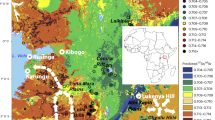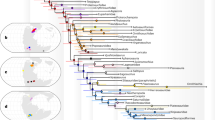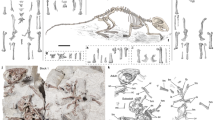Abstract
The use of high-resolution stratigraphical control in studying the species sequencing patterns of early Eocene mammals has recently been demonstrated by Gingerich et al.1–5. These studies have documented the nature of the tempo and mode of evolution and have stimulated the debate between adherents of phyletic gradualism and punctuated equilibria6. All studies have been largely verticalist (evolutionary) in outlook, equating change within a single basin of deposition with evolution. However, when I applied these techniques to the early Eocene condylarth, Phenacodus, I found a strong lateral (biogeographical and ecological) component influencing the sequencing of species in a single basin. I report here that Phenacodus species are relatively static in size and morphology throughout the local section studied, and two of these show statistically significant discontinuities in temporal range. The clumped re-entry of these species after local disappearance along with the introduction of other new taxa points to ecological control of vertical events within a local section.
This is a preview of subscription content, access via your institution
Access options
Subscribe to this journal
Receive 51 print issues and online access
$199.00 per year
only $3.90 per issue
Buy this article
- Purchase on SpringerLink
- Instant access to full article PDF
Prices may be subject to local taxes which are calculated during checkout
Similar content being viewed by others
References
Gingerich, P. D. Nature 248, 107–109 (1974).
Gingerich, P. D. Am. J. Sci. 276, 1–28 (1976).
Gingerich, P. D. & Simons, E. L. Contr. Mus. Paleont. Univ. Mich. 24, 245–279 (1977).
Gingerich, P. D. & Gunnell, G. Contr. Mus. Paleont. Univ. Mich. 25, 125–153 (1978).
Bookstein, F. L., Gingerich, P. D. & Kluge, A. G. Paleobiology 4, 120–134 (1978).
Gould, S. J. & Eldrege, N. Paleobiology 3, 115–151 (1977).
Schankler, D. M. Univ. Mich. Pap. Paleont. 24, 99–114 (1980).
Bown, T. & Kraus, M. Palaeogeogr. Palaeoclimatol. Palaeoecol. 34, 1–30 (1981).
West, R. M. Contr. Biol. Geol. Milwaukee publ. Mus. 6, 1–78 (1976).
Granger, W. Bull. Am. Mus. nat. Hist. 34, 329–361 (1915).
Simpson, G. G. Am. Mus. Novit. 954, 1–24 (1937).
Gingerich, P. D. J. Paleont. 48, 895–903 (1974).
Gingerich, P. D. & Winkler, D. A. J. Mammal. 60, 691–704 (1979).
Gingerich, P. D. & Ryan, A. S. Primates 20, 141–159 (1979).
Guthrie, D. A. Ann. Carneg. Mus. 43, 47–113 (1971).
Rose, K. Univ. Mich. Pap. Paleont. (in the press).
Gazin, C. L. Smithson. misc. Collns 149, 1–98 (1965).
Wing, S. Univ. Mich. Pap. Paleont. 24, 119–125 (1980).
Author information
Authors and Affiliations
Rights and permissions
About this article
Cite this article
Schankler, D. Local extinction and ecological re-entry of early Eocene mammals. Nature 293, 135 (1981). https://doi.org/10.1038/293135a0
Received:
Accepted:
Issue date:
DOI: https://doi.org/10.1038/293135a0
This article is cited by
-
Punctuated equilibrium comes of age
Nature (1993)
-
Gradual phyletic evolution at the generic level in early Eocene omomyid primates
Nature (1984)
-
Gaps in the fossil record
Nature (1982)



